Extractive Exchange
The re-staging of a copper mine into an e-waste facility
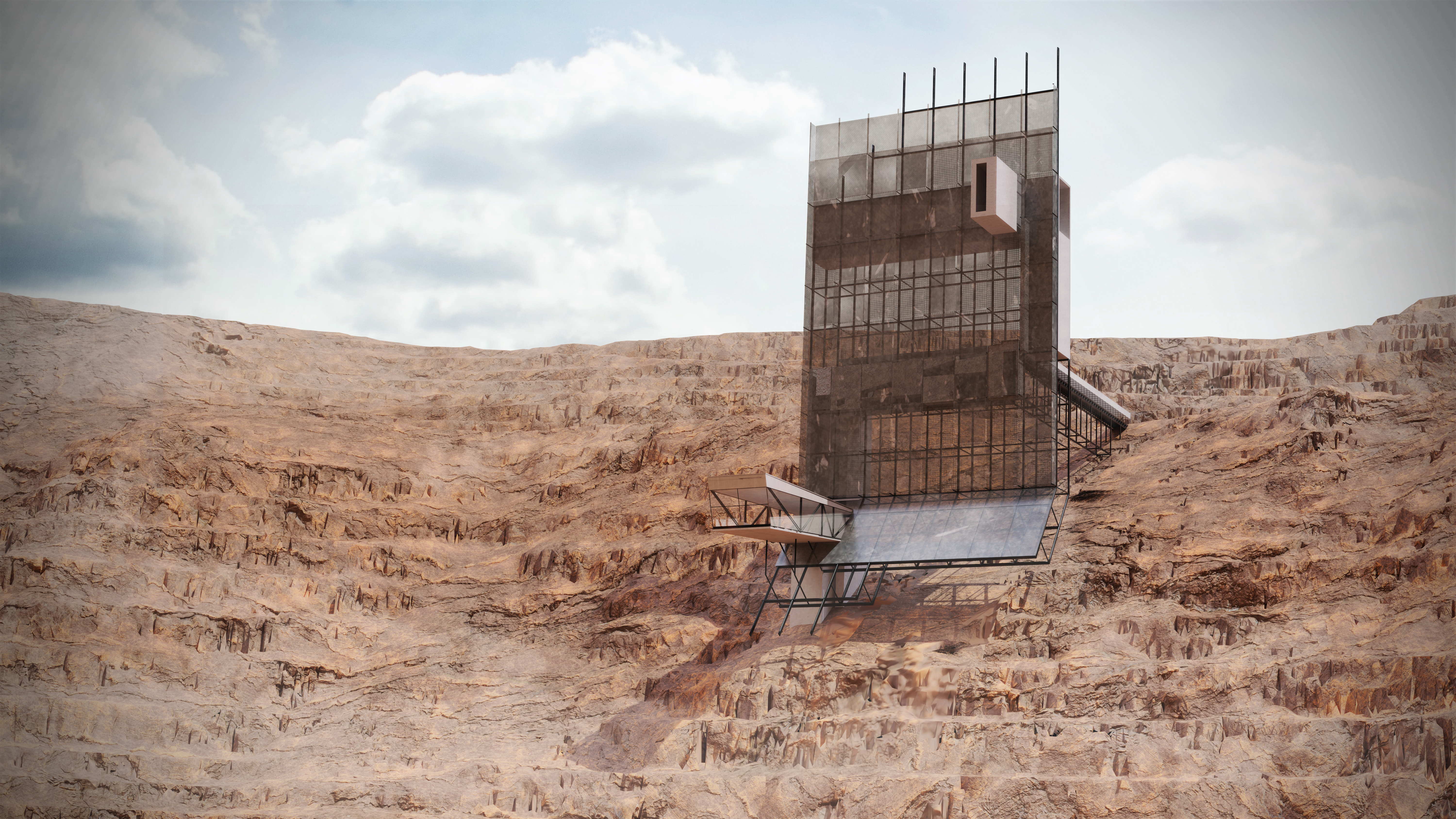
E-Waste Facility
Morenci, Arizona
Done with Kady Cramer.
Extractive Exchange proposes an architecture that engages the scale of humankind’s present consumptive behaviors and the resulting consequences by staging new methods of extraction and disassembly within the lifecycle of e-waste set against and within the constructed landscape of Morenci AZ. Design of the facilities for the project learn from and draw upon the existing formal qualities and technologies of the site. Be it in the form of conveyor belts, concentrators, leaching pits, or flat stockpiles, our design approach seeks to repurpose, re-assemble, and re-deploy these elements into “re-combinants” that shift the meaning of once destructive processes into ones that atone for their production. As a re-staging of the disassembly process, the project envisions a series of interventions that propose new landscapes for the collection, sorting, shredding, recycling, and visitation of e-waste. This mechanical choreography accepts our present condition and finds new fantastical, but grounded worlds for human and material cohabitation within the spectacular opera of a ‘new circularity’
![]()
The Morenci Copper Mine is the largest open-pit copper mine in Arizona producing over 800 million pounds every year, the highest mass extracted at any mine in North America. This production feeds America's need for copper, satisfying the demand of our hyper-consumptive contemporary condition. The process of extraction at Morenci has been enabled by massive mechanical systems, machines and innovations in processing that are constantly revised to maximize production. Containing relics of old and unused machinery on site in stockpiles, Morenci’s pit is simultaneously an active and evolving byproduct of extractive processes, and a reliquarium of outmoded technologies. Given its profound transformation over time and the sublime landscape that has resulted, the copper mine also acts as a physical construct with which we can measure and trace the impact of human interactions with our environments. Once exhausted and abandoned by its operations, copper mines like Morenci are resounding scars - petrified reminders of anthropogenic and exploitative activity. Current practice requires such sites to be reclaimed - the process by which the landform is returned to its original contour profile. Our fascination with the processes surrounding extraction revealed a stream of products that contribute the most to demand, but also carry a potential for alternate models for ‘reclaiming’ due to their inherent embodiment of processed copper - electronic goods.
![]()
![]()
![]()
![]()
(Kevin McElvaney, The Guardian)
Almost 50 million tons of e-waste (electronic waste) are generated worldwide every year, clogging our global waste-stream. The material flows of e-waste circumscribe different territories and connect different industrial systems, from the mine to the factory. However, its most destructive environmental impact is when it produces a landfill. A large volume of these second hand, condemned, and discarded electronic goods that utilize copper arrive in “developing” countries such as Ghana as an illegal export propelled in part by lack of e-waste regulations in the United States. This results in an augmented landscape with an abundance of devalued waste electronics as characterized by bizarre scenographies such as televisions forming ad-hoc bridges to span toxic water bodies. E-waste comes with an exploitative and damaging dimension of human labor that is unavoidable due to the containment of valuable materials within electronics, requiring manual handling and attention to its disassembly. This global phenomena threatens severe environmental damage and risk to human health that warrants rethinking and restaging. We approach the context of the Morenci landscape replete with its remaining systems and machinery as a site in which alternatives might be imagined.
![]()
![]()
Thus, we propose a regenerative agenda that shifts the identity of Morenci into a speculative and fully automated management center for our e-waste processing, reconstitution and disposal. Our work is entangled with questions of environmental urgency, global extraction and waste flows, and an obsession with cycles of production, consumption and waste streams. By unpacking the totality of e-waste and bringing it full circle to the extracted minerals found within copper mines, we hope to reveal new possibilities that are both hi-technology and hi-typology.
As a re-staging of the disassembly process, the project envisions a series of three interventions that propose new landscapes for the collection, sorting, shredding, recycling, and visitation of e-waste. This mechanical choreography accepts our present condition and finds new fantastical, but grounded worlds for human and material cohabitation within the spectacular opera of a ‘new circularity’.
Morenci, Arizona
Done with Kady Cramer.
Extractive Exchange proposes an architecture that engages the scale of humankind’s present consumptive behaviors and the resulting consequences by staging new methods of extraction and disassembly within the lifecycle of e-waste set against and within the constructed landscape of Morenci AZ. Design of the facilities for the project learn from and draw upon the existing formal qualities and technologies of the site. Be it in the form of conveyor belts, concentrators, leaching pits, or flat stockpiles, our design approach seeks to repurpose, re-assemble, and re-deploy these elements into “re-combinants” that shift the meaning of once destructive processes into ones that atone for their production. As a re-staging of the disassembly process, the project envisions a series of interventions that propose new landscapes for the collection, sorting, shredding, recycling, and visitation of e-waste. This mechanical choreography accepts our present condition and finds new fantastical, but grounded worlds for human and material cohabitation within the spectacular opera of a ‘new circularity’
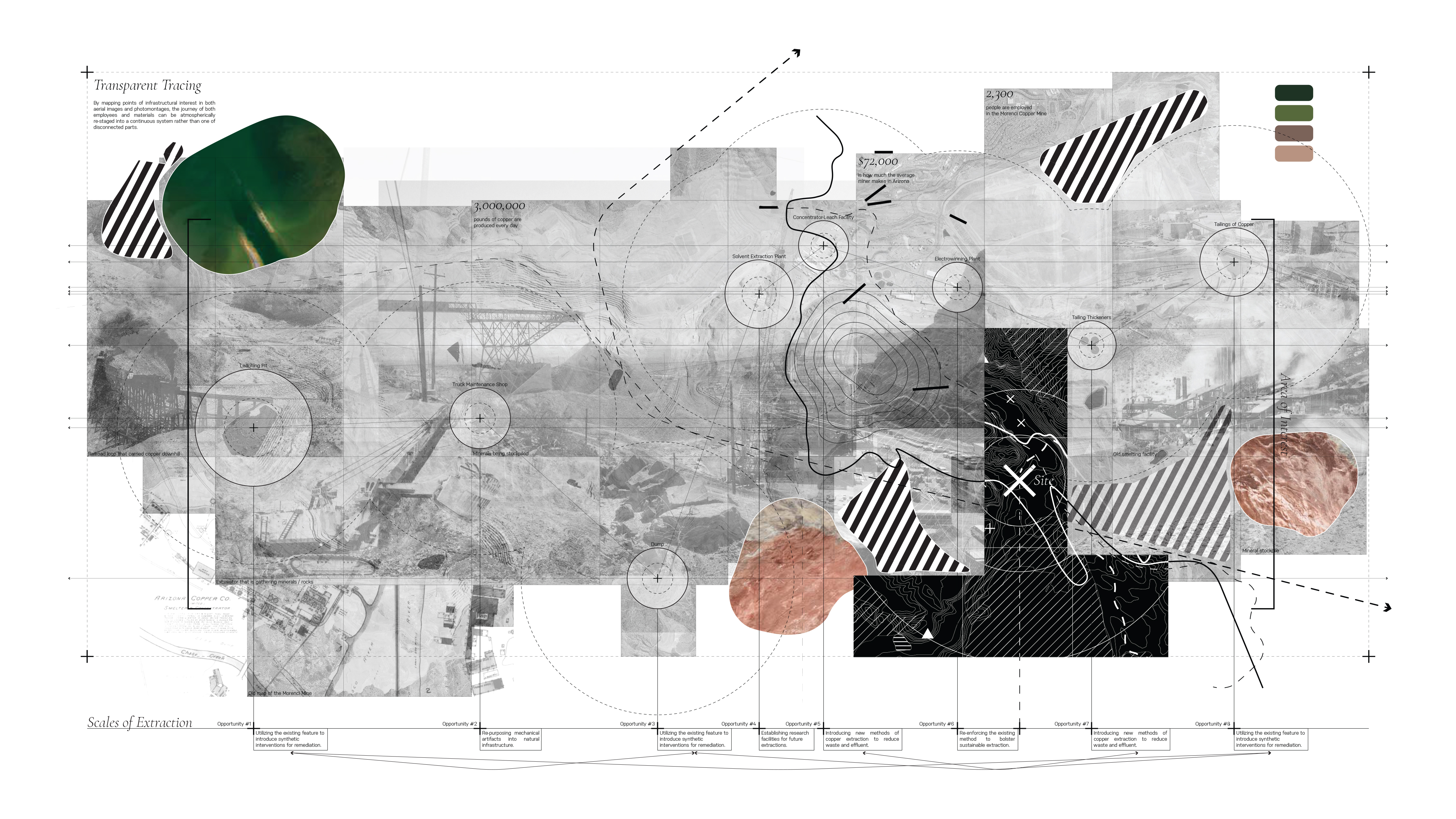
The Morenci Copper Mine is the largest open-pit copper mine in Arizona producing over 800 million pounds every year, the highest mass extracted at any mine in North America. This production feeds America's need for copper, satisfying the demand of our hyper-consumptive contemporary condition. The process of extraction at Morenci has been enabled by massive mechanical systems, machines and innovations in processing that are constantly revised to maximize production. Containing relics of old and unused machinery on site in stockpiles, Morenci’s pit is simultaneously an active and evolving byproduct of extractive processes, and a reliquarium of outmoded technologies. Given its profound transformation over time and the sublime landscape that has resulted, the copper mine also acts as a physical construct with which we can measure and trace the impact of human interactions with our environments. Once exhausted and abandoned by its operations, copper mines like Morenci are resounding scars - petrified reminders of anthropogenic and exploitative activity. Current practice requires such sites to be reclaimed - the process by which the landform is returned to its original contour profile. Our fascination with the processes surrounding extraction revealed a stream of products that contribute the most to demand, but also carry a potential for alternate models for ‘reclaiming’ due to their inherent embodiment of processed copper - electronic goods.
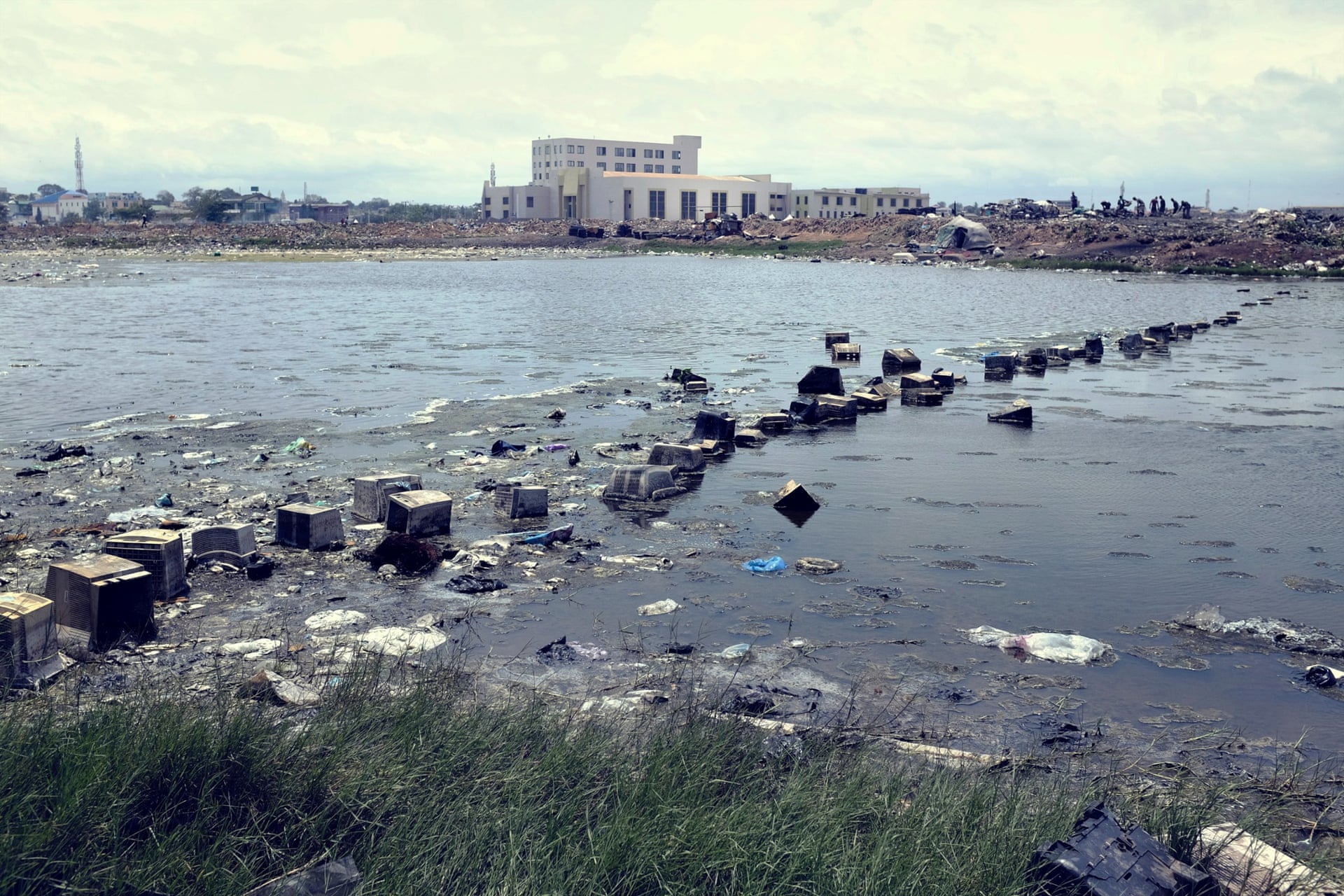
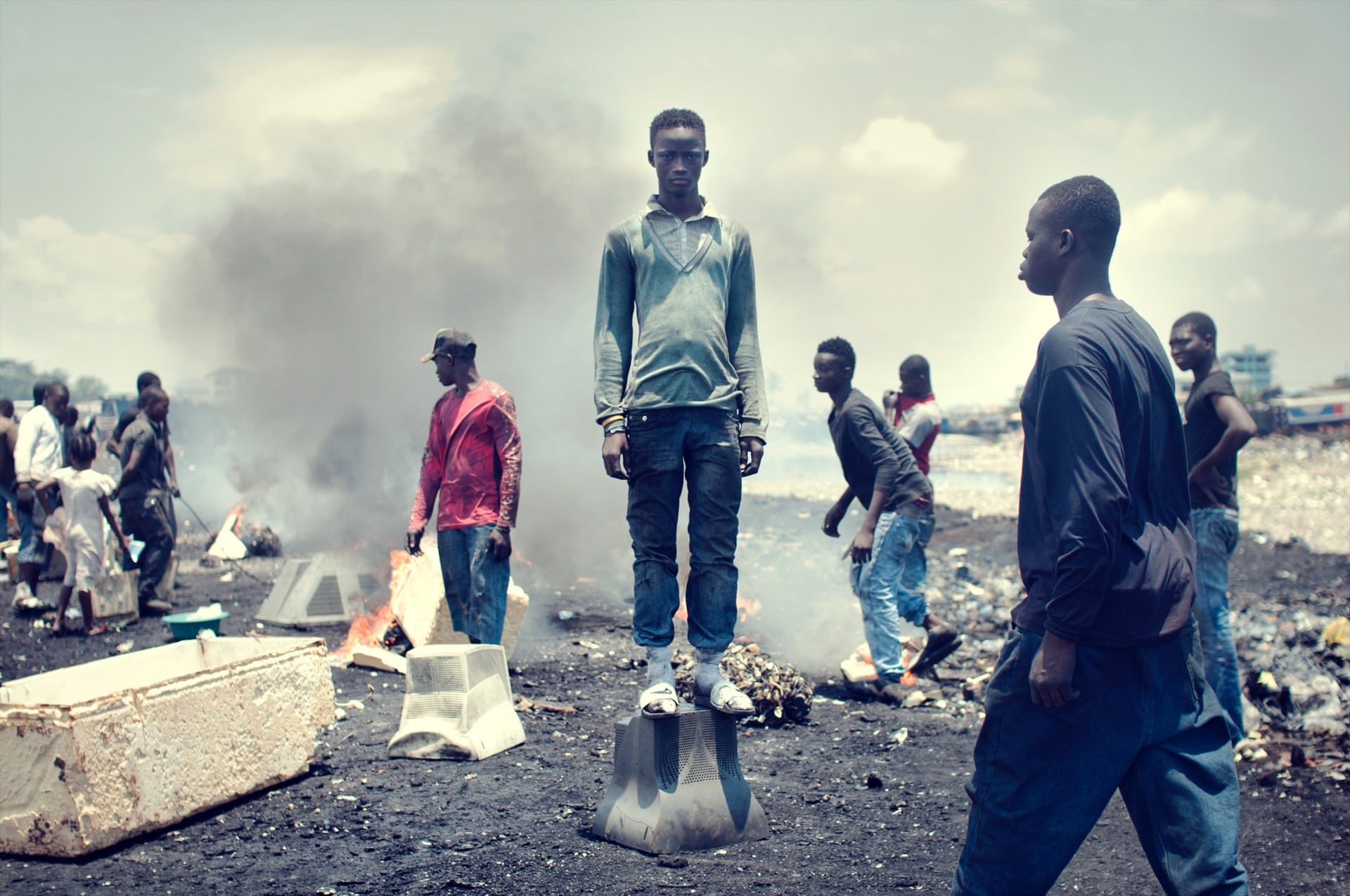
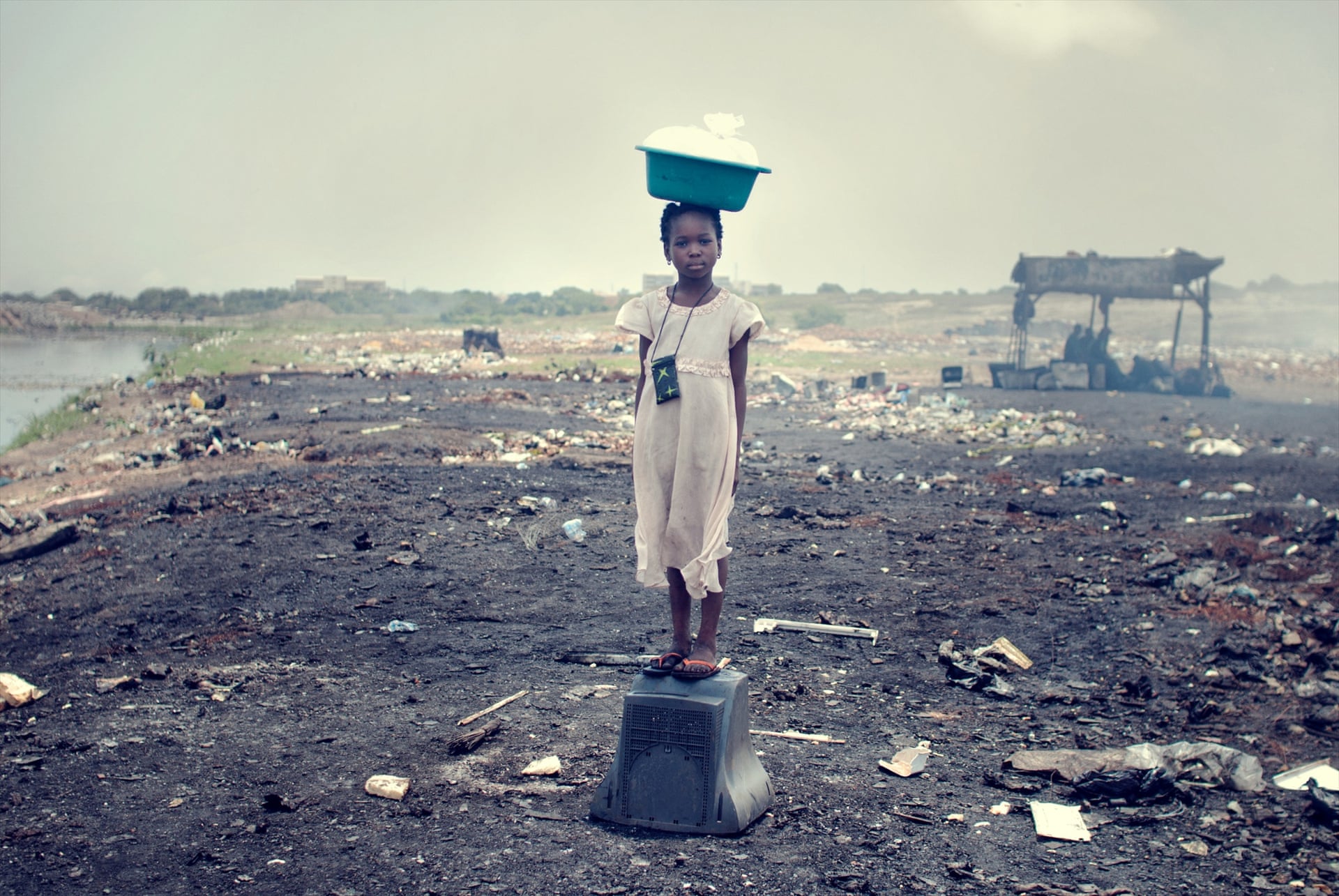

(Kevin McElvaney, The Guardian)
Almost 50 million tons of e-waste (electronic waste) are generated worldwide every year, clogging our global waste-stream. The material flows of e-waste circumscribe different territories and connect different industrial systems, from the mine to the factory. However, its most destructive environmental impact is when it produces a landfill. A large volume of these second hand, condemned, and discarded electronic goods that utilize copper arrive in “developing” countries such as Ghana as an illegal export propelled in part by lack of e-waste regulations in the United States. This results in an augmented landscape with an abundance of devalued waste electronics as characterized by bizarre scenographies such as televisions forming ad-hoc bridges to span toxic water bodies. E-waste comes with an exploitative and damaging dimension of human labor that is unavoidable due to the containment of valuable materials within electronics, requiring manual handling and attention to its disassembly. This global phenomena threatens severe environmental damage and risk to human health that warrants rethinking and restaging. We approach the context of the Morenci landscape replete with its remaining systems and machinery as a site in which alternatives might be imagined.
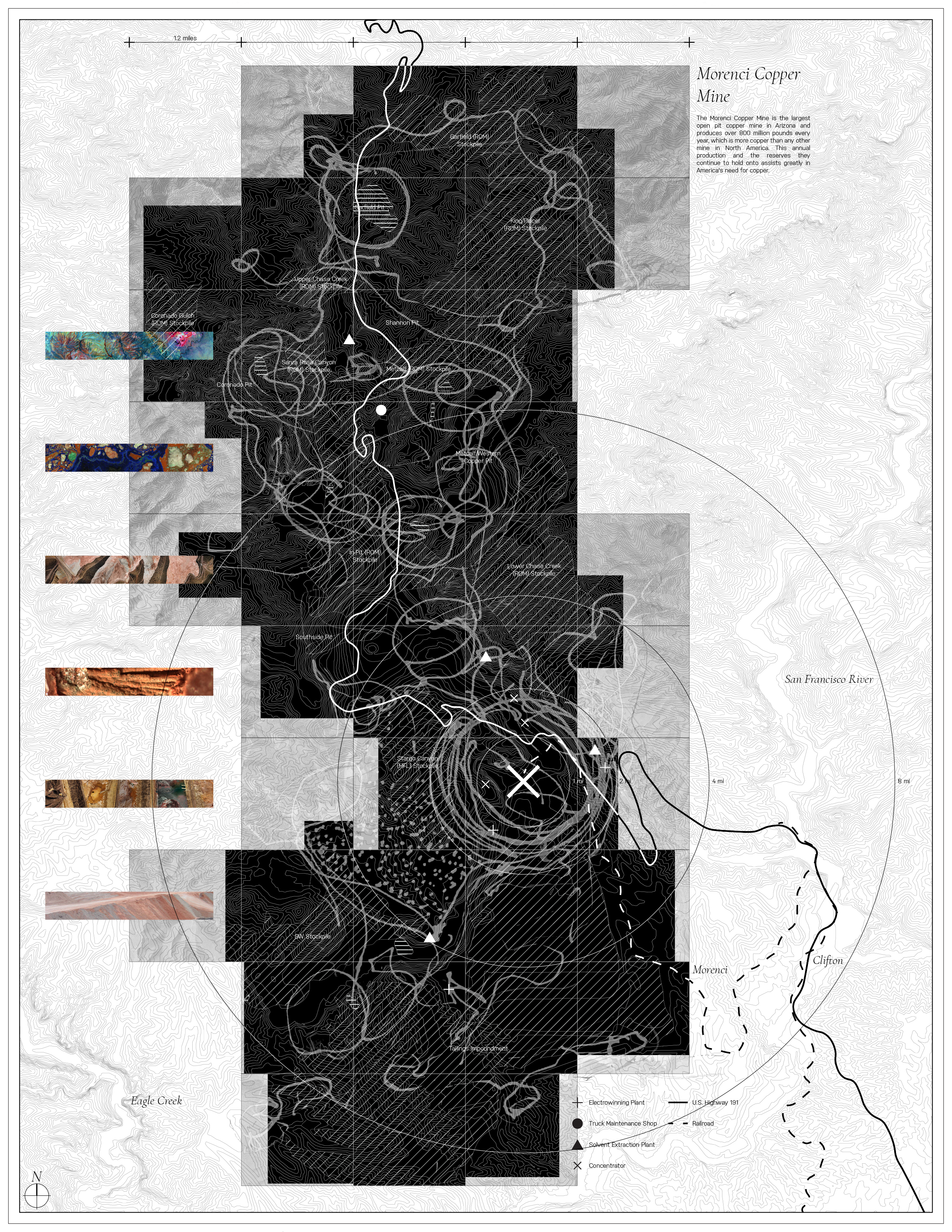

Thus, we propose a regenerative agenda that shifts the identity of Morenci into a speculative and fully automated management center for our e-waste processing, reconstitution and disposal. Our work is entangled with questions of environmental urgency, global extraction and waste flows, and an obsession with cycles of production, consumption and waste streams. By unpacking the totality of e-waste and bringing it full circle to the extracted minerals found within copper mines, we hope to reveal new possibilities that are both hi-technology and hi-typology.
As a re-staging of the disassembly process, the project envisions a series of three interventions that propose new landscapes for the collection, sorting, shredding, recycling, and visitation of e-waste. This mechanical choreography accepts our present condition and finds new fantastical, but grounded worlds for human and material cohabitation within the spectacular opera of a ‘new circularity’.
Collection Cathedral


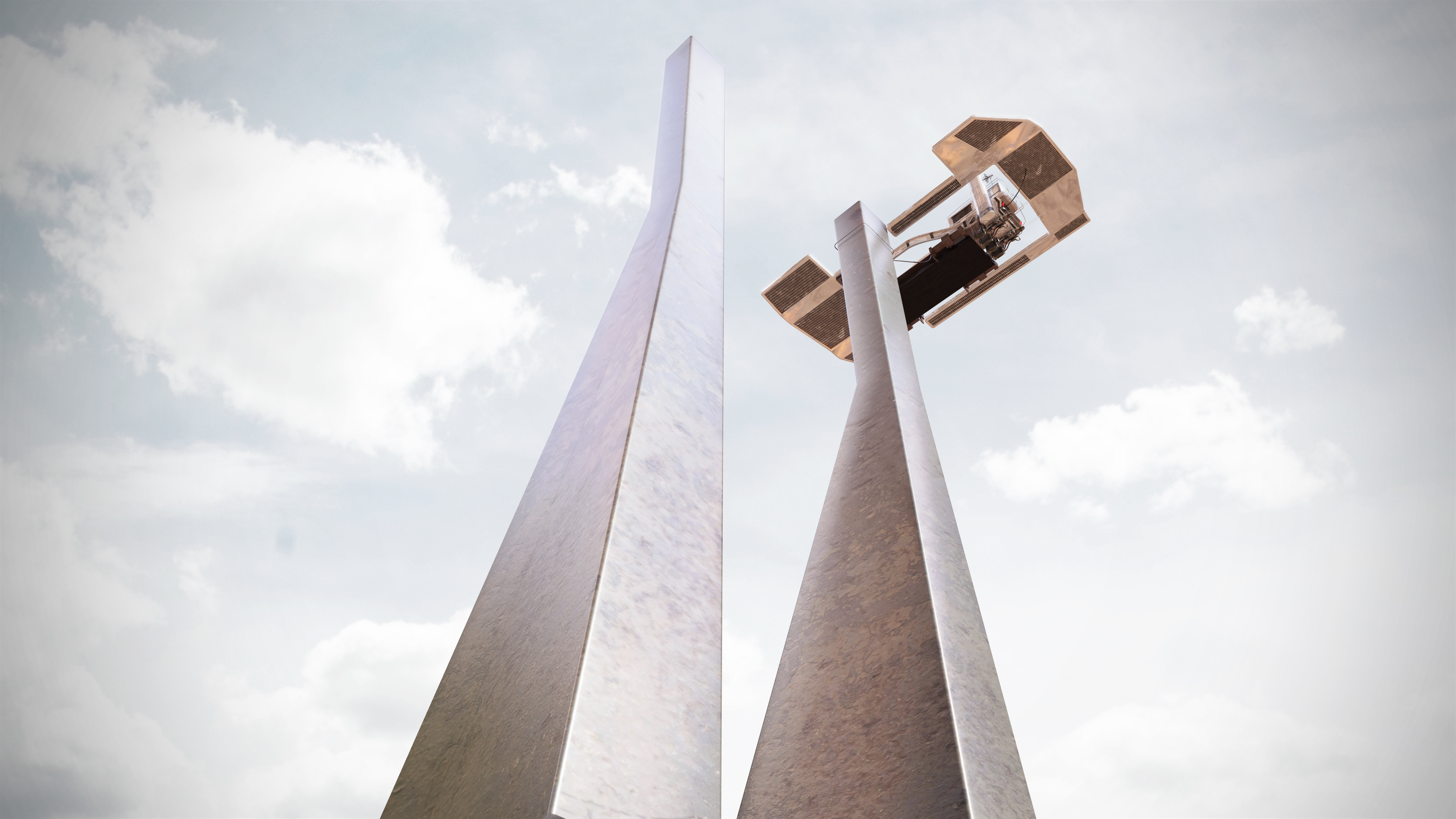
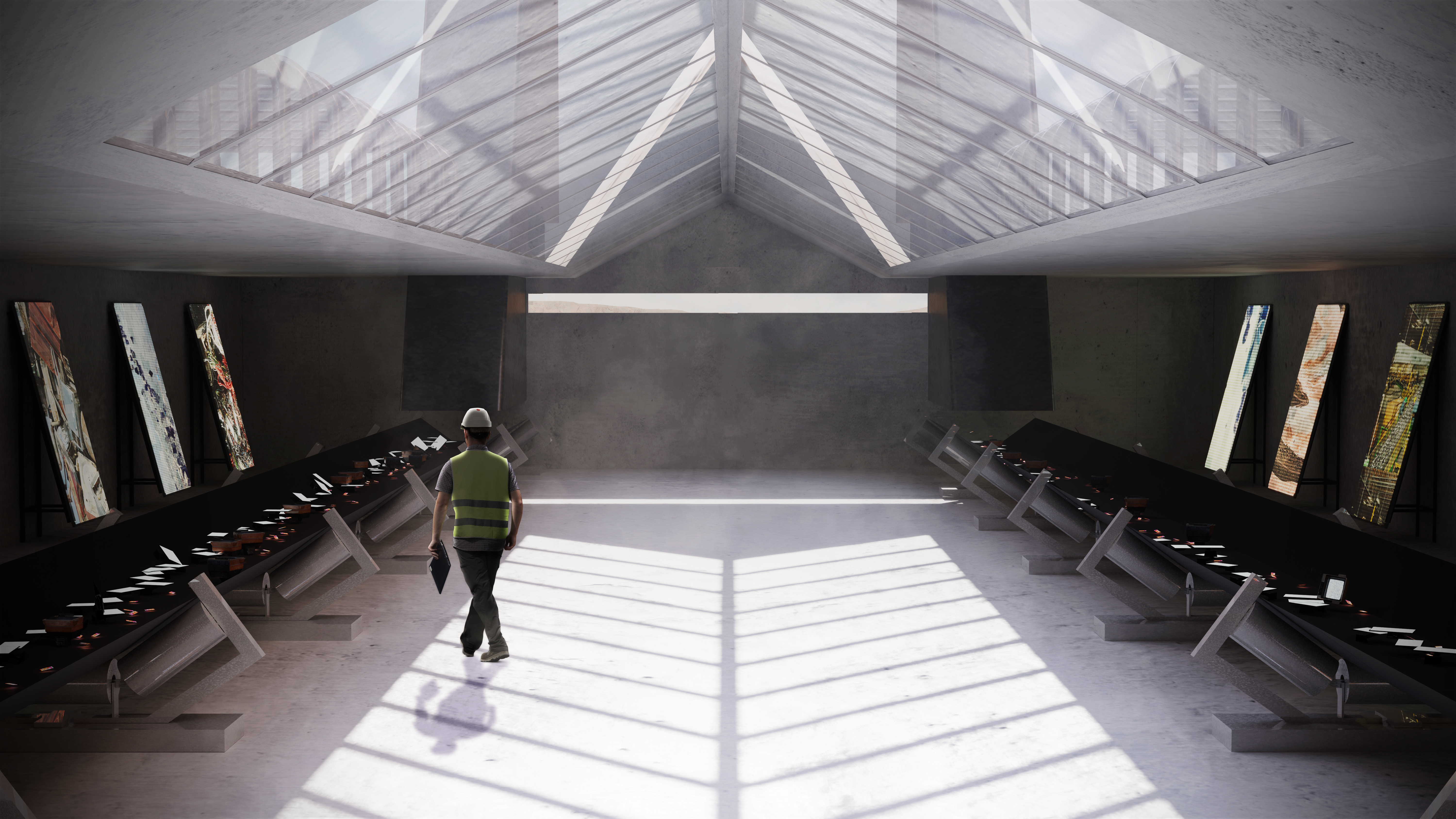

A floating vehicle that uses the magnetic charge of copper mines to float and collect electronic waste from local sites to be processed and recycled. These vehicles are made in the truck maintenance facility that already exists on the site and re-purposes previously decommissioned trailers, dump trucks, and other industrial vehicles. This allows the functionality of the floating vehicle to reflect the utility of its previous form, so they range in size and typology. This solves the problem that we found in our research that most communities and populations simply do not know how to recycle their e-waste or where to dispose of it, so these vehicles roam and orbit the nearby landscape, picking up and collecting these electronic goods.
Accompanying this is the Collection Cathedral, an intervention that repurposes smelter smoke stacks into vertical chutes that act as beacons for the vehicles to deliver the objects, releasing them from the consumptive ecological grasp of the surrounding areas.
The collection facility houses the preliminary stages that must be followed when treating e-waste before metal, glass, plastic, chemicals, cartridges, batteries, and so on can be manually separated and shredded. As the floating vehicle dumps e-waste into the smokestack chutes, it is filtered into separate paths: a top floor and a bottom floor.
E-waste on the top floor is regarded as uncontaminated and therefore proceeds neatly through a conveyor belt onward where it is monitored by staff. The next phases of treatment include dust extraction which is discarded in an environmentally compliant manner through vacuums, and the introduction of strong overhead magnets that help separate steel and iron from other wastes.
Specific waste regarded as complex or polluted is brought to the bottom floor through a series of magnetic chutes within the larger smoke stack structures and is then treated with an acid leach that sanitizes the goods from any harmful surface exposure before they proceed. It follows the same treatment as the waste on the top floor, before finally surfacing to the ground level where it is carried by conveyor belts to other parts of the site.
Accompanying this is the Collection Cathedral, an intervention that repurposes smelter smoke stacks into vertical chutes that act as beacons for the vehicles to deliver the objects, releasing them from the consumptive ecological grasp of the surrounding areas.
The collection facility houses the preliminary stages that must be followed when treating e-waste before metal, glass, plastic, chemicals, cartridges, batteries, and so on can be manually separated and shredded. As the floating vehicle dumps e-waste into the smokestack chutes, it is filtered into separate paths: a top floor and a bottom floor.
E-waste on the top floor is regarded as uncontaminated and therefore proceeds neatly through a conveyor belt onward where it is monitored by staff. The next phases of treatment include dust extraction which is discarded in an environmentally compliant manner through vacuums, and the introduction of strong overhead magnets that help separate steel and iron from other wastes.
Specific waste regarded as complex or polluted is brought to the bottom floor through a series of magnetic chutes within the larger smoke stack structures and is then treated with an acid leach that sanitizes the goods from any harmful surface exposure before they proceed. It follows the same treatment as the waste on the top floor, before finally surfacing to the ground level where it is carried by conveyor belts to other parts of the site.

Migratory Mediator

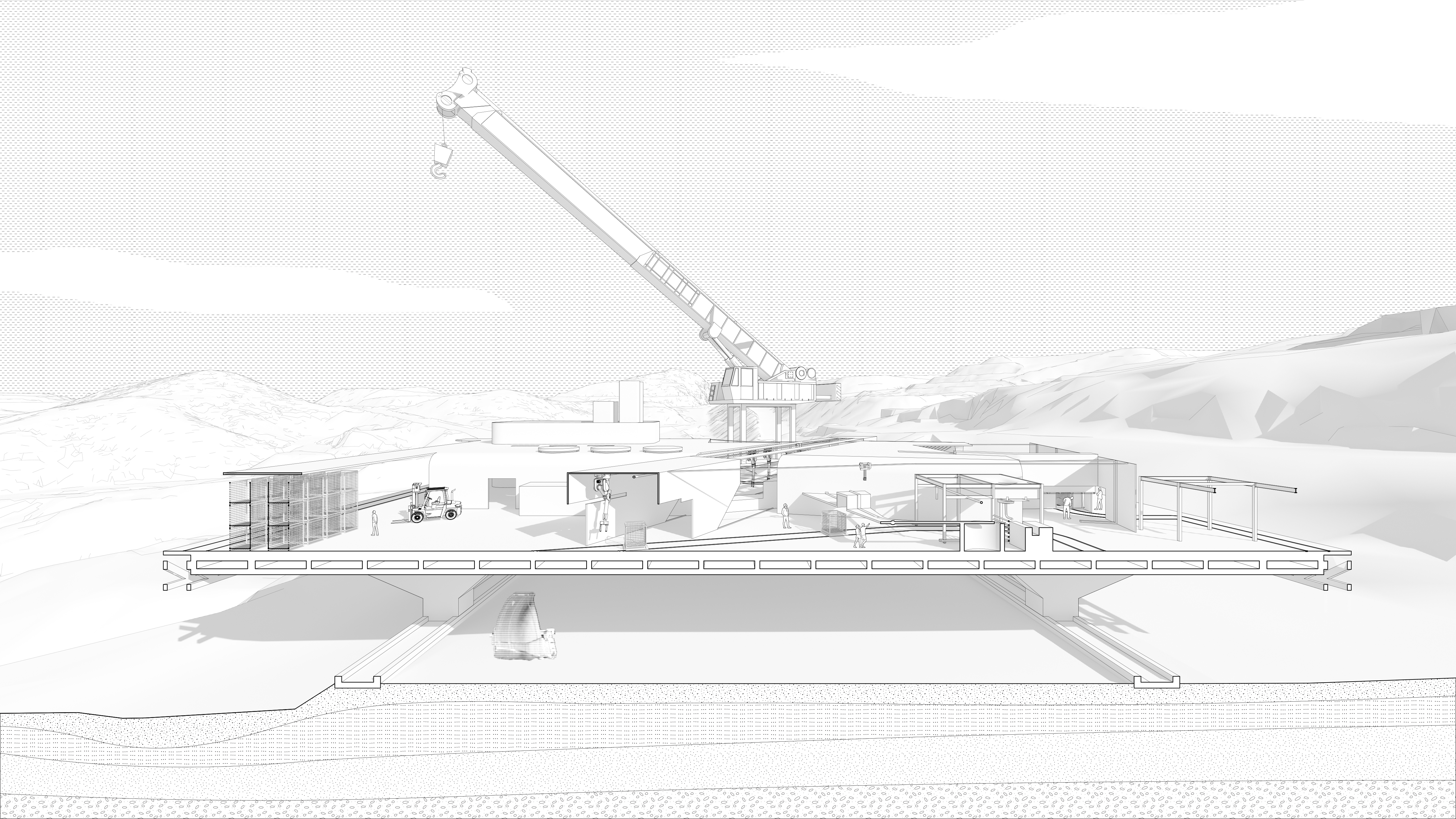



However, some mechanical processes require circuit boards, copper, and aluminum from other wastes particles to be separated from each other. So the second intervention, the Migratory Mediator, acts as a medium for the act of disassembly and houses the machinery necessary to sort, shred, and recycle electronic products.
Inspired by machines that are required to be mobile due to the ever expanding nature of copper mines, this building borrows that quality and travels to different parts of the site through a track. Using the existing operational plan to distinguish points of requisite within the landscape, such as acid ponds, elevated plateaus, and isolated slag zones, the Migratory Mediator links together these disparate districts.
The building fits into various pockets around the site, allowing its function to shift from burning to shredding to recycling according to its location. This intervention utilizes storage and organizational techniques denoted by objects such as bins and cranes to pick up waste that was collected by the previous intervention. Vertical stacks are closed off for the burning of plastics from copper wires, robotic arms are used for the dismantling of circuit boards before they arrive at shredders, and magnetic ducts are placed throughout to separate valuable metals from shredded glass, plastics, etc. which are then broken down even further to prepare for their own re-use.
The Migratory Mediator also acts as a people mover, housing small interventions that allow visitors to oversee these activities safely. Every year over the course of a single day, the mediator shifts its gears and stops its processes in order to ferry visitors to the site's gift shop, which is located at the bottom of the deepest pit in the Morenci Mine. By being forced to move around the site at the crawling pace of the machine, one observes the site from the standpoint and pace of the process.
Inspired by machines that are required to be mobile due to the ever expanding nature of copper mines, this building borrows that quality and travels to different parts of the site through a track. Using the existing operational plan to distinguish points of requisite within the landscape, such as acid ponds, elevated plateaus, and isolated slag zones, the Migratory Mediator links together these disparate districts.
The building fits into various pockets around the site, allowing its function to shift from burning to shredding to recycling according to its location. This intervention utilizes storage and organizational techniques denoted by objects such as bins and cranes to pick up waste that was collected by the previous intervention. Vertical stacks are closed off for the burning of plastics from copper wires, robotic arms are used for the dismantling of circuit boards before they arrive at shredders, and magnetic ducts are placed throughout to separate valuable metals from shredded glass, plastics, etc. which are then broken down even further to prepare for their own re-use.
The Migratory Mediator also acts as a people mover, housing small interventions that allow visitors to oversee these activities safely. Every year over the course of a single day, the mediator shifts its gears and stops its processes in order to ferry visitors to the site's gift shop, which is located at the bottom of the deepest pit in the Morenci Mine. By being forced to move around the site at the crawling pace of the machine, one observes the site from the standpoint and pace of the process.
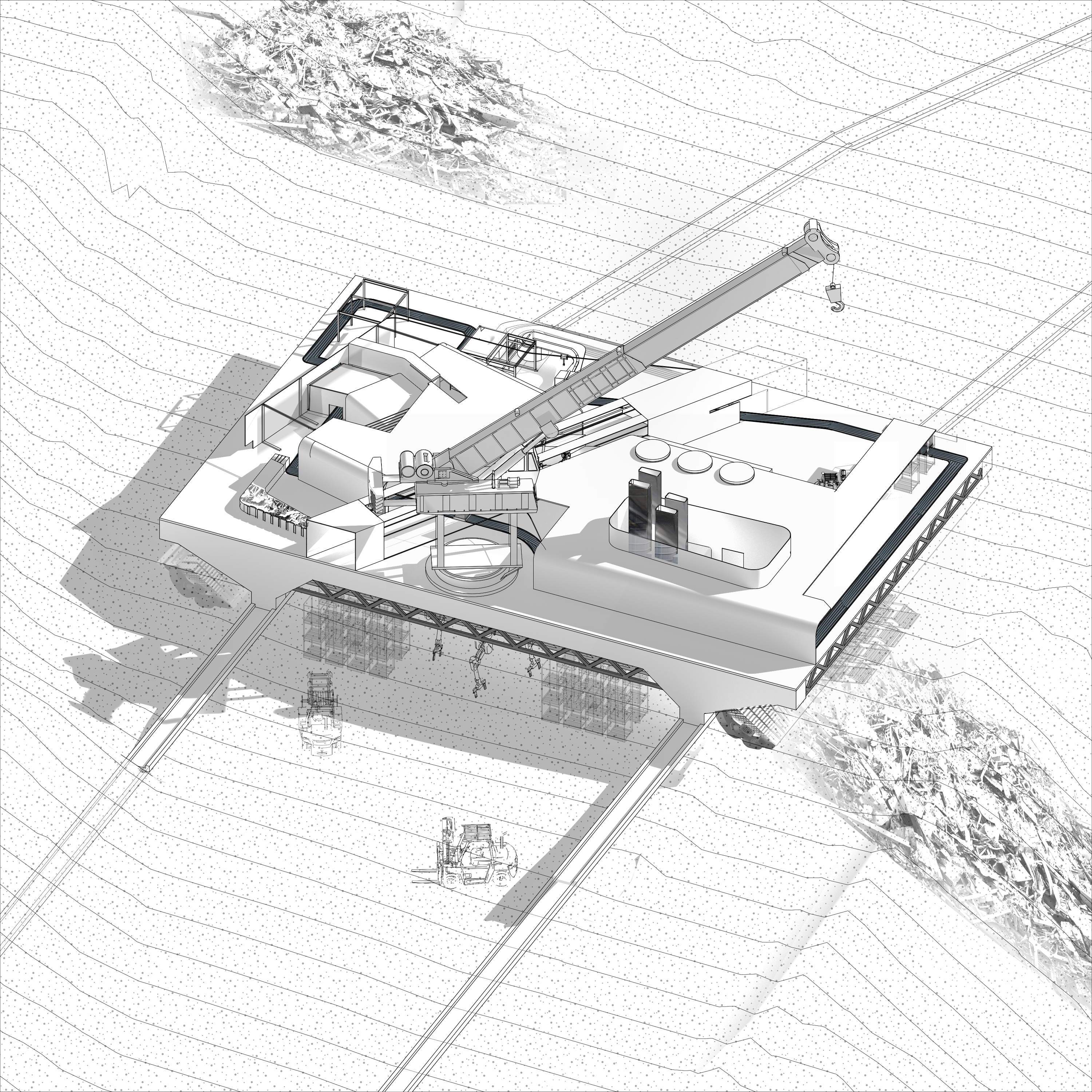
Synthetic Screen



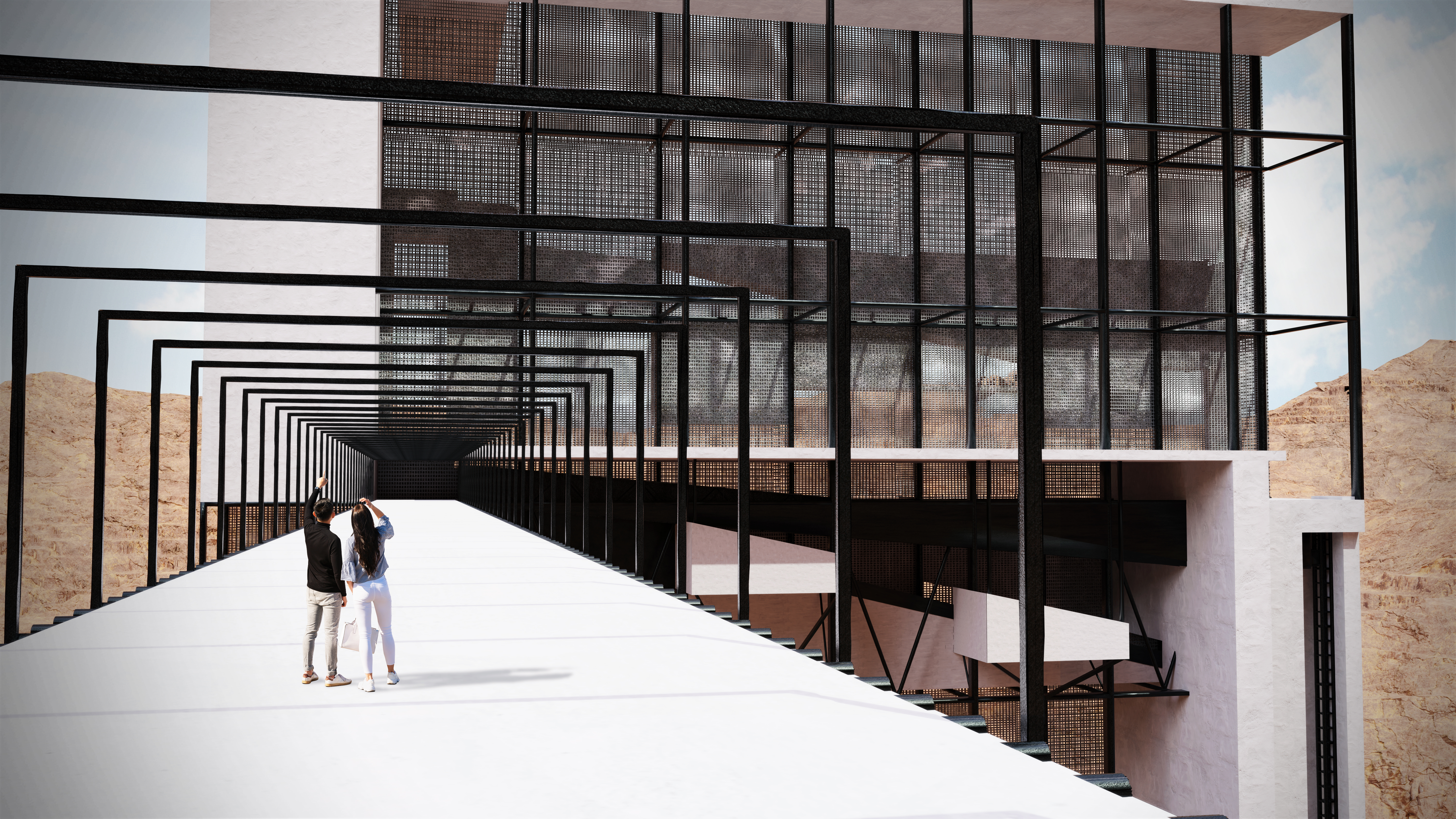
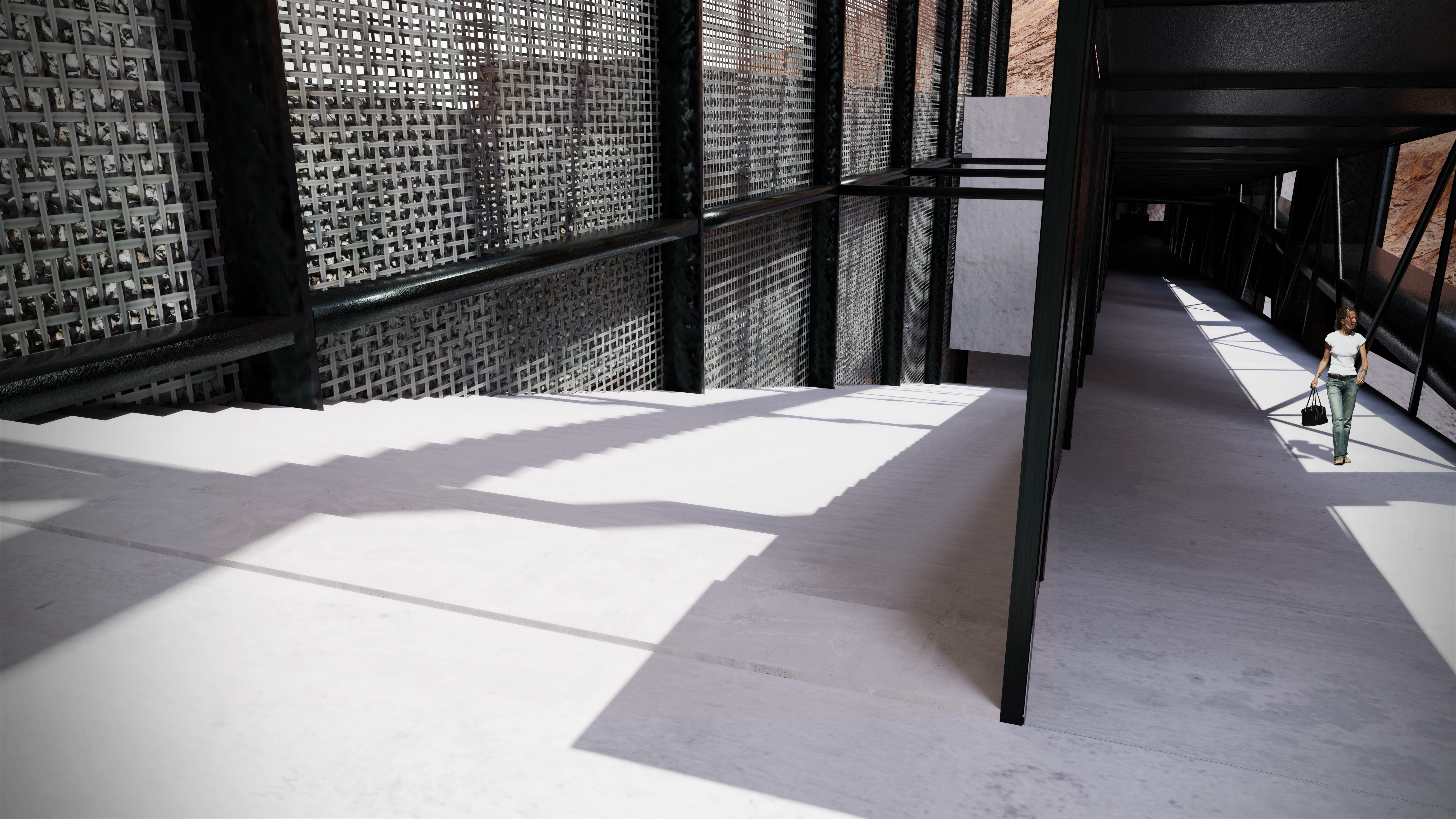
Tying these all together is the Synthetic Screen, an intervention in the form of a visitor tower that fills in collapsed portions of the Morenci Copper Mine, offering observation points and a unique sense of verticality for outsiders to absorb the varying competing scales of the site’s proposed e-waste management facilities. Here, one may partake in a view that is otherwise foreign to the horizontal span of the mine and leave with a deeper understanding of the consumptive situation.
The Screen showcases the massive view of the site that was produced by the mine’s extraction by offering a viewpoint for visitors to look down into the massive pit. Through the structure and materials of the architecture, this sublime view overlaps with the residual scars below. By doing so, it begins to showcase the competing scales of the site by illustrating the irrelevance of the human body when it’s compared to such an immense scalar gap.
The visual technique of the mesh screen allows visitors to differentiate the image of Morenci from a lived experience, almost like a camera lens that accurately showcases a specific moment within the site as opposed to the vast expanse of Morenci’s totality.
The over-sized structural system constrains the visitor to the intentional views of the process, marking fixed points along its path where its users hardly recognize the monumental scene behind it, making Morenci an object that moves from background to foreground throughout one’s occupation of this vertical icon.
The Screen showcases the massive view of the site that was produced by the mine’s extraction by offering a viewpoint for visitors to look down into the massive pit. Through the structure and materials of the architecture, this sublime view overlaps with the residual scars below. By doing so, it begins to showcase the competing scales of the site by illustrating the irrelevance of the human body when it’s compared to such an immense scalar gap.
The visual technique of the mesh screen allows visitors to differentiate the image of Morenci from a lived experience, almost like a camera lens that accurately showcases a specific moment within the site as opposed to the vast expanse of Morenci’s totality.
The over-sized structural system constrains the visitor to the intentional views of the process, marking fixed points along its path where its users hardly recognize the monumental scene behind it, making Morenci an object that moves from background to foreground throughout one’s occupation of this vertical icon.


With these three interventions, Extractive Exchange proposes an architecture that engages the scale of humankind’s present consumptive behaviors and the resulting consequences by staging new methods of extraction and disassembly within the lifecycle of e-waste set against and within the constructed landscape of the Morenci Copper Mine.